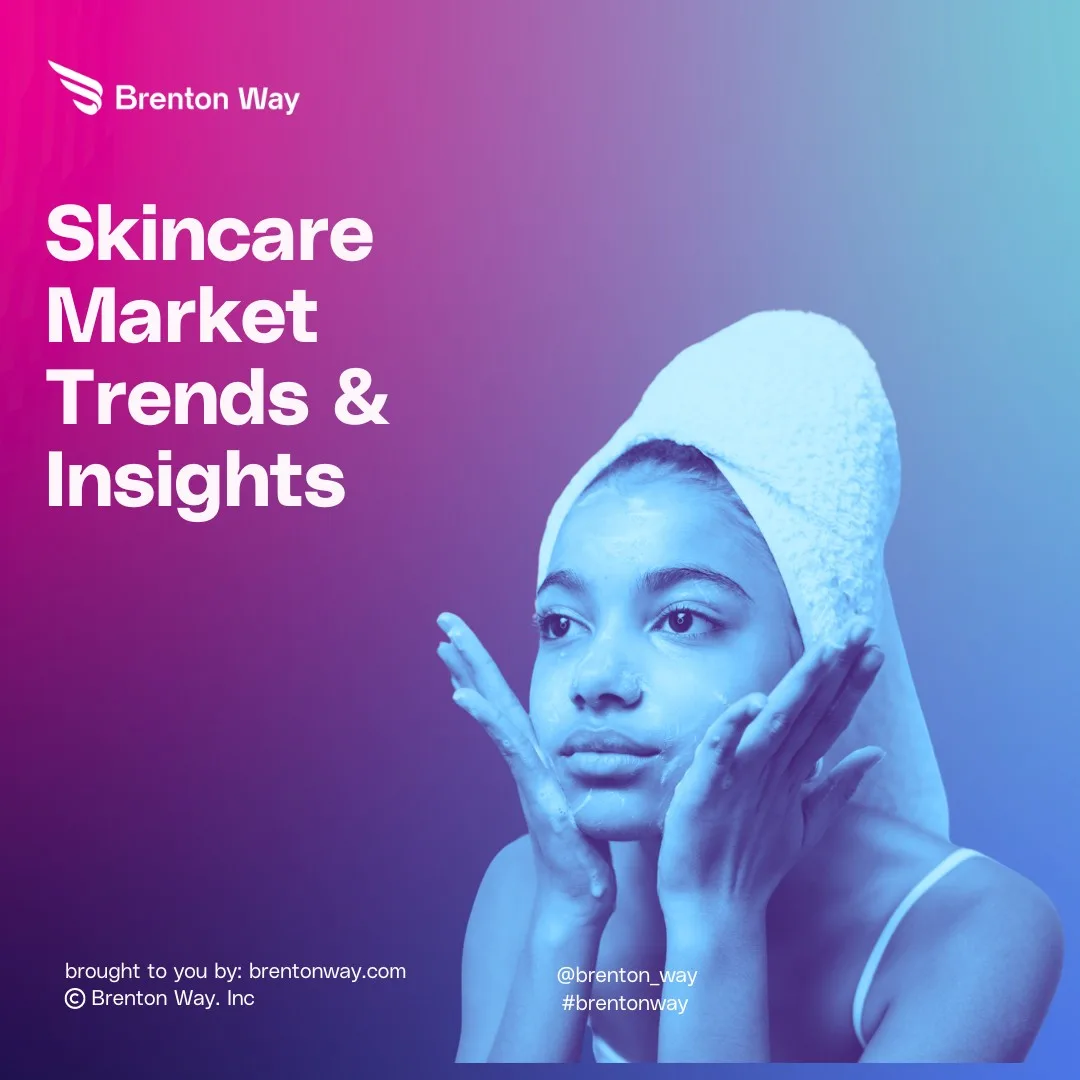
The skin care market size has experienced consistent growth, becoming a significant segment within the broader beauty advertising and personal care industry. As of the latest assessments, the market exhibits a promising trajectory, characterized by an increasing demand for diverse skincare solutions. In this article, I will cover: Overview of the Skin Care Market Size […]

The skin care market size has experienced consistent growth, becoming a significant segment within the broader beauty advertising and personal care industry. As of the latest assessments, the market exhibits a promising trajectory, characterized by an increasing demand for diverse skincare solutions.
In this article, I will cover:
The global skin care market size stands as a dynamic and influential sector within the beauty and personal care industry. As individuals place increasing emphasis on skin health and well-being, the market’s significance continues to grow.
Also See: Cosmetic Branding: How To Build a Beauty Brand
The skin care market’s current scale is substantial, with billions of dollars in revenue generated annually. Brands, ranging from established giants to innovative newcomers, compete to cater to the diverse needs and preferences of consumers across the globe. The market encompasses an extensive range of products, from cleansers and moisturizers to specialized treatments targeting various skin concerns.
(Source: Statista)
Looking ahead, the skin care market is poised for promising expansion. The table below highlights the skin care market growth projection:
| Market Size Value in 2023 | USD 142.14 billion |
| Revenue Forecast in 2030 | USD 196.20 billion |
| Growth Rate | CAGR of 4.7% from 2023 to 2030 |
| Base Year for Estimation | 2022 |
A seismic shift in consumer behavior has redefined the skincare landscape. Consumers are no longer merely seeking cosmetic enhancements but are investing in products that promote skin health and radiance. This shift is evident in the rise of clean, organic, and natural skincare products.
Also See: Best Salon Marketing Ideas
Health-conscious consumers are scrutinizing ingredient lists, favoring products free from harmful chemicals and embracing formulations with botanical and plant-based components.
Consumers are shifting from a mere focus on external appearance to a holistic approach centered around overall well-being. Skincare is viewed as an essential component of self-care, with individuals seeking products that promote skin health, radiance, and vitality.
Also See: How To Do Hair Salon SEO
A significant shift toward clean and natural beauty is evident. Consumers are scrutinizing ingredient lists, avoiding harsh chemicals, and embracing products with botanical and plant-based components. Brands are responding by formulating products that are transparent about their ingredients’ origins and benefits.
The digital age has empowered consumers with information at their fingertips. Social media, beauty blogs, and YouTube tutorials serve as virtual classrooms where users educate themselves about skincare ingredients, routines, and product efficacy. This trend drives informed decision-making and fosters a more knowledgeable consumer base.
Also See: Top Beauty Marketing Services
The desire for personalized experiences extends to skincare. Consumers seek products tailored to their skin type, concerns, and preferences. This trend has given rise to quizzes, AI algorithms, and diagnostic tools that guide users toward products best suited to their individual needs.
Sustainability and ethics have become paramount considerations for consumers. Brands embracing eco-friendly practices, recyclable packaging, and cruelty-free formulations resonate strongly with ethically conscious individuals who want their skincare choices to align with their values.
The pervasive influence of social media platforms cannot be underestimated. Beauty influencers, product reviews, and before-and-after photos shape trends and drive product discovery. Consumers are swayed by the experiences and recommendations of their digital peers.
Inspired by Korean beauty routines, multi-step skincare rituals have gained popularity. Consumers are embracing cleansing, toning, serums, masks, and moisturizers as part of their daily regimen. This trend has led to a surge in demand for targeted products that complement each step.
The skincare product market is a tapestry woven with diverse offerings. From cleansers and moisturizers to serums, masks, and specialized treatments, the market caters to a broad spectrum of skincare needs.
One of the cornerstones of skincare segmentation is tailoring products to different skin types. From oily and dry to combination and sensitive, brands formulate products that address specific characteristics. Moisturizers, cleansers, and treatments are crafted with ingredients that harmonize with each skin type’s unique demands.
Also See: Beauty Copywriting: Tips & Best Practices
Skincare needs evolve with age, and the industry acknowledges this by offering age-targeted formulations. Youthful skin benefits from preventive products, while mature skin seeks anti-aging solutions. Products like serums, eye creams, and moisturizers are designed to cater to the changing needs of individuals across various life stages.
The skincare market excels in addressing a plethora of concerns and conditions. Acne-fighting products, hyperpigmentation remedies, and solutions for redness and irritation are just a few examples. Brands formulate products infused with active ingredients that target these specific issues, providing users with tailored solutions.
Given the increasing awareness of sun damage and environmental stressors, sun protection and shielding products have become pivotal. Sunscreens, moisturizers with SPF, and antioxidant-rich formulations help safeguard the skin from UV rays, pollution, and blue light exposure.
Skincare is influenced by cultural and regional factors. Brands recognize these nuances and offer products that align with specific preferences. Whitening products popular in some Asian markets, for instance, reflect cultural ideals, while products tailored to specific climates address varying environmental challenges.
Beyond the basics, the skincare market showcases an array of specialized treatments. From exfoliants and masks to serums targeting specific concerns, these products offer targeted solutions for users seeking intensive care and results.
Here are the top ways how technology is influencing the skin care and beauty industry:
Several factors contribute to the burgeoning growth of the skincare product market:
Also See: Skin Care SEO Guide
Here are the top ways how sustainability is impacting the beauty and skin care industry:
Consumers are seeking products with ingredients that are not only safe for their skin but also for the planet. Brands are opting for clean formulations devoid of harmful chemicals, parabens, and sulfates. This approach aligns with the broader goal of reducing the environmental impact of skincare products.
The issue of excessive packaging waste is being addressed through innovative solutions. Brands are transitioning to eco-friendly materials and minimalistic designs to minimize their ecological footprint. Refillable containers, biodegradable packaging, and reduced plastic use are all becoming prominent trends.
Ingredients sourced sustainably are gaining traction. Brands are prioritizing raw materials obtained through ethical and environmentally conscious practices. This approach not only benefits ecosystems but also supports communities involved in ingredient cultivation. Reduced
Water is a precious resource, and its conservation is essential. Brands are developing products that require less water during manufacturing and usage. Waterless skincare formulations, such as solid cleansers and concentrated serums, are emerging as innovative solutions.
The concept of circularity is gaining momentum. Brands are exploring upcycling by repurposing by-products and waste materials from other industries for use in skincare products. Moreover, promoting recycling and facilitating responsible disposal of product containers is becoming a standard practice.
The shift toward sustainability is accompanied by consumer education. Brands are transparently communicating their eco-friendly initiatives, allowing consumers to make informed choices aligned with their values.
Collaborative efforts within the industry are driving change. Beauty conglomerates, startups, and regulatory bodies are coming together to set sustainability standards, share best practices, and propel the skincare industry toward a greener future.
Embarking on the path ahead, the realm of skincare products is poised to embrace a calculated journey with a projected CAGR of 4.69% over the forthcoming half-decade.
In the September of 2021, Kao Corporation introduced the world to its innovative creation – the Smile Performer Sheet Mask. This mask asserts its prowess in bestowing a luminous radiance and a vivacious bounce to the complexion, culminating in an effervescent impression that is akin to a smile made manifest.
As the masses become more attuned to skin-related concerns and corresponding treatments, the adoption of skincare products commences at an earlier juncture in the personal care journey. This paradigm shift is a pivotal driving force propelling market expansion.
A surge in the embrace of anti-aging products, including revered names such as L’Oreal Revitalift, Avon Anew Sensitive+, and Caudalie’s premier cru anti-aging cream enriched with hyaluronic acid, contributes significantly to the landscape’s vitality.
Inclinations veer toward organic skincare solutions, and this predilection is poised to cultivate market advancement in the future.
A bevy of sought-after products, ranging from vitamin C serums to hyaluronic acid creams and nourishing face masks, emerge as the market beneficiaries.
For instance, the June of 2022 witnessed the unveiling of a groundbreaking creation from Australia’s clean cosmeceutical trailblazer, Biologi. The anti-pollution serum, baptized “Bg defence,” unfurls as the latest jewel in Biologi’s serum crown, harnessing the potency of wild-harvested extracts infused with vitamin C, niacinamide, and salicylic acid.
The digital age has ushered in a new era of beauty and skincare, significantly shaped by the influence of social media platforms. Social influencers are playing a positive impact on the skin care market size.
Social media platforms are teeming with beauty influencers and content creators who wield immense influence. For instance, people love to see Instagram beauty influencers and their skincare routines. The product reviews and recommendations offered by social media celebrities resonate with millions of followers, driving trends and product discoveries.
Also See: Best Influencer Marketing Agencies in 2023
Consumers now have access to real-time reviews and feedback from fellow users. This transparent information sharing enables individuals to make more informed decisions about which skincare products to try and which to avoid.
Social media is a hotbed for trendspotting. Viral challenges via cosmetics advertising, such as 10-step skincare routines and #shelfies showcasing product collections, introducing new routines and products to a global audience, is shaping the direction of skincare trends.
Social media serves as a vast educational platform. Beauty enthusiasts and experts use platforms like Instagram, TikTok, and YouTube to disseminate skincare knowledge, from explaining ingredient benefits to demonstrating application techniques.
Brands gain exposure through influencer partnerships and user-generated content. Social media acts as a launchpad for emerging brands, enabling them to reach a broad audience and establish a presence within the competitive skincare market.
Social media fosters a culture of instant gratification and the fear of missing out (FOMO). Consumers feel compelled to try trending products to be a part of the conversation and experience the latest in skincare innovation.
Skincare enthusiasts share their journeys on social media, documenting their experiences with various products. This user-generated content provides valuable insights into how different products work for different individuals, enabling personalization.
The men’s grooming segment is undergoing a significant transformation, fueled by changing attitudes toward self-care and grooming among men. Let’s delve into the growth trajectory of the men’s grooming industry and the abundant opportunities it presents.
The demand for high-quality products has given rise to premium and specialty men’s grooming brands. These brands prioritize ingredients, formulations, and packaging that resonate with the discerning male consumer.
Also See: Skincare Branding: The Definitive Guide
Social media and male influencers are playing a pivotal role in reshaping grooming norms. Men are exposed to a plethora of grooming content, tips, and product recommendations, which further drive interest and engagement in grooming routines.
Ecommerce platforms provide men with easy access to a wide range of grooming products. The convenience of online shopping appeals to the busy modern man, contributing to the growth of the segment.
The men’s grooming segment is not limited by geographical boundaries. Opportunities for growth exist in both developed and emerging markets as men across diverse cultures become more invested in their grooming routines.
Despite the optimistic landscape, the skincare product market faces challenges. The influx of countless products, each making bold claims, can overwhelm consumers. Ensuring transparency, efficacy, and safety will be crucial for brands aiming to stand out.
Moreover, sustainability concerns are pushing brands to adopt eco-friendly practices and packaging, presenting an opportunity to resonate with environmentally conscious consumers.
Challenges:
Opportunities:
Looking ahead, the market for skincare products shows promise for more growth and innovation. The intersection of science, technology, and natural ingredients will drive the creation of advanced formulas catering to individual needs.


